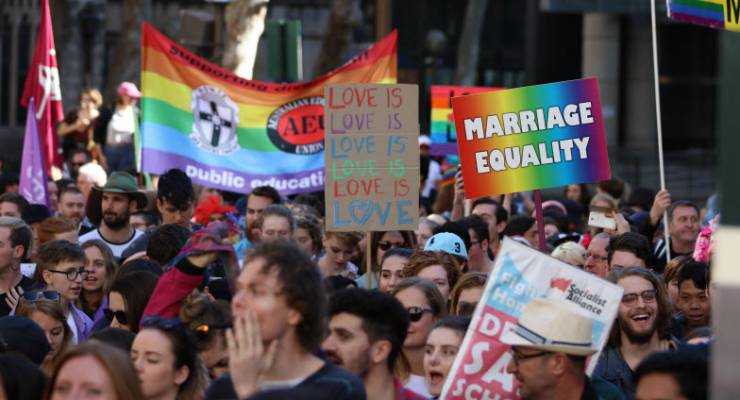
Yes and No campaigners in the contentious marriage equality ballot are forced to confront an unfamiliar challenge for political operators in Australia: the challenge of actually getting people cast their vote.
The last time voting was voluntary in an Australian general federal election was 1922, when 59% of eligible voters turned up to cast a vote. The turnout to last year’s general election was the lowest since then. So what are the respective campaigns doing to ensure people’s support translates into physically and correctly filling out a ballot paper? And how successful are the respective campaigns likely to be?
Political marketing strategist Toby Ralph said the opt-in nature of the vote was akin to an American election.
“They must get people out to vote, so they’ll need practical strategies that encourage this,” he said, speaking about the Yes camp.
“They’ll need to get people voting early, because likelihood to do so evaporates with time. They’ll need to do things encouraging younger voters to get together with their friends or families and vote, with a ‘designated driver’ to find the post box they’ve never used.”
But Ralph said the problems for the Yes case are compounded by “both expectations of a Yes victory and demographics”.
“The prevailing attitude of the ambivalent soft voters, many of whom say they are happy if same-sex couples get married so the country can move on to other issues, is that they feel their vote isn’t important, because Yes will win anyway,” he said.
“Demographically, older people are more inclined to vote than younger ones, and while No voters are under-represented across all ages, the percentage share of them climbs with age. If you play all these factors through, the numbers tighten up considerably, the two thirds one third community opinion gets nearer to a close call. That said, it’s likely that Yes will win, I’m guessing 62:38, but there’s a long way to go yet, and many mistakes can turn the numbers on their head.”
Tiernan Brady, executive director of the Equality Campaign, told Crikey he has “great faith” that younger voters will turn out in large numbers.
“The rush of people registering or updating their details tells you people are hungry to be part of this process,” he said. “Because this isn’t just a standard election where they have to vote for politicians, this is about their friends and family and co-workers; this is personal.”
However, Ralph told Crikey the voluntary nature of the survey could skew the numbers away from the “will of the community”.
“The last decent independent numbers I saw had 40% hard voters for Yes, 20% for No, and two thirds of the remaining soft 40% leaning to Yes. Thus, were it compulsory the result, if held today, would be 66% Yes, and 44% No,” he said.
“The voluntary aspect confounds that though, as only 65% of people are itching to vote, and 15% more claim they are likely to. In realistic terms, this means that only about three quarters of eligible voters seem likely to bother, and, interestingly, the No voters, while fewer in number, are more inclined to [vote] than Yes supporters.”
Brady said the marriage equality campaign had had to learn lessons from the US and Europe, where non-compulsory voting is far more common.
The Coalition for Marriage didn’t respond to Crikey’s questions before deadline, but leaked documents outlining talking points for No campaign volunteers offered some insight into the tactics of the No campaign. Door knockers are encouraged to “engage people’s natural sense of caution and suspicion”, sticking to a “slippery slope” line — focusing on the potential consequences of a change in the law.
“They know they can’t win if the question is just about Marriage,” Brady said. “So they talk about everything but marriage — every day we see another distraction.”
Ralph said the Yes campaign had to avoid buying into the “red herring arguments of the No case whose strategy must be to conflate same-sex marriage with political correctness, sex education, thin-end-of-the-wedge-to-polygamy or ‘if you don’t know what you’re voting for don’t vote for it’ style claims” and ensure they didn’t alienate swinging voters by using the campaign as a “chance to vent”.
“There’s no shortage of furious protagonists who want to call little old churchgoing ladies homophobic bigots,” he said.
“Far from helping their cause, this strongly bolsters the No case.”
The No campaign also faces big problems, Ralph says.
“To win, they must build expectations of a Yes win, thus the importance of containing victory with No votes. Like the Yes campaigners, they must silence their fanatical fringe, for when they speak they start bleeding votes.”








Lodging a postal survey form is somewhat different from going to a nearby primary school on polling day. Usually I have to drive there, stand in a queue, refuse or accept how-to-vote cards, give my name and address and respond that I have not voted already, vote, buy a sausage or some cakes on my way out and then go on my way. This time I found the form in my letter box, opened it, ticked the yes box, put it in the envelope provided, sealed it and put it in my bag. When I later went shopping I put it in a box at the PO. Yes the non-compulsory aspect is unusual but I am so annoyed by the ads and absurd claims made by the opponent of marriage equality that I never considered not voting.
Personally, I am against marriage – gay, straight, serial or polyamorous – but as long as it doesn’t impede me too much am prepared to ignore it, as one does with blowflies & god botherers.
However, though I would prefer to boycott this bullshit junk mail fudge, I will vote YES to poke the bigots, knuckle draggers & hate merchants in the eye.
Speaking of the “yes” campaign, where are they? I see that awful, dishonest “no” ad on TV every night here in Newcastle, but not once have I seen a “yes” ad.
Would it persuade you either way if you saw yes ads on TV?